RCM and FMEA: Benefits, Limitations, and Case Study Analysis
VerifiedAdded on 2022/09/15
|7
|3308
|17
Report
AI Summary
This report provides a comprehensive analysis of Reliability Centered Maintenance (RCM) and Failure Mode and Effects Analysis (FMEA). It begins with an overview of RCM, detailing its principles, advantages, and disadvantages, followed by a similar overview of FMEA. The report then presents a review of a journal article focusing on an RCM implementation case study in a process plant, summarizing the methodology, findings, and critique. Furthermore, the report includes an FMEA worksheet developed for a specific system, and identifies the top three failure modes successfully mitigated by the team's recommended actions, explaining the rationale behind these actions. The report adheres to the assignment brief's requirements, utilizing relevant standards and referencing appropriate texts. The content is contributed by a student and is available on Desklib, a platform providing AI-based study tools.
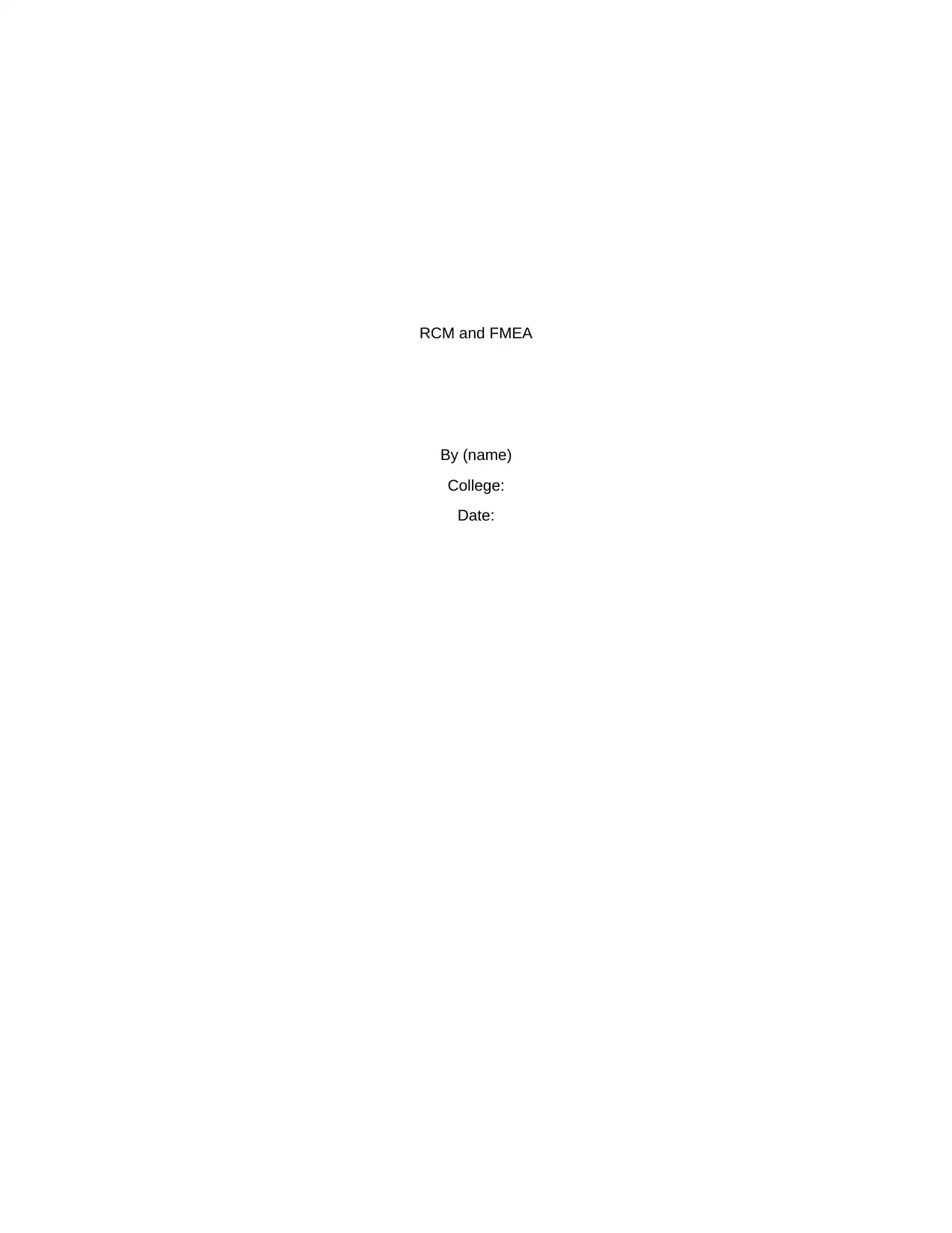
RCM and FMEA
By (name)
College:
Date:
By (name)
College:
Date:
Paraphrase This Document
Need a fresh take? Get an instant paraphrase of this document with our AI Paraphraser
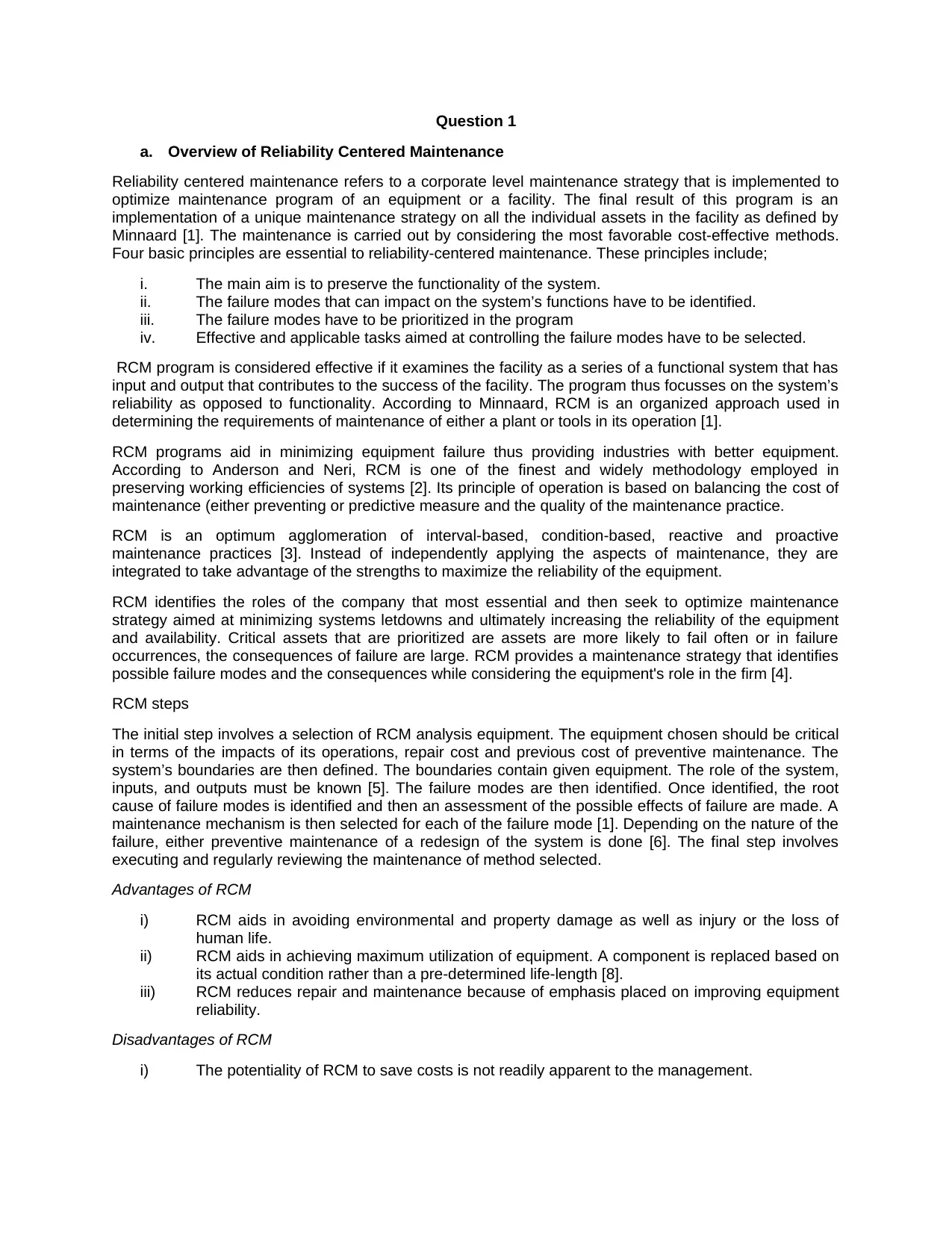
Question 1
a. Overview of Reliability Centered Maintenance
Reliability centered maintenance refers to a corporate level maintenance strategy that is implemented to
optimize maintenance program of an equipment or a facility. The final result of this program is an
implementation of a unique maintenance strategy on all the individual assets in the facility as defined by
Minnaard [1]. The maintenance is carried out by considering the most favorable cost-effective methods.
Four basic principles are essential to reliability-centered maintenance. These principles include;
i. The main aim is to preserve the functionality of the system.
ii. The failure modes that can impact on the system’s functions have to be identified.
iii. The failure modes have to be prioritized in the program
iv. Effective and applicable tasks aimed at controlling the failure modes have to be selected.
RCM program is considered effective if it examines the facility as a series of a functional system that has
input and output that contributes to the success of the facility. The program thus focusses on the system’s
reliability as opposed to functionality. According to Minnaard, RCM is an organized approach used in
determining the requirements of maintenance of either a plant or tools in its operation [1].
RCM programs aid in minimizing equipment failure thus providing industries with better equipment.
According to Anderson and Neri, RCM is one of the finest and widely methodology employed in
preserving working efficiencies of systems [2]. Its principle of operation is based on balancing the cost of
maintenance (either preventing or predictive measure and the quality of the maintenance practice.
RCM is an optimum agglomeration of interval-based, condition-based, reactive and proactive
maintenance practices [3]. Instead of independently applying the aspects of maintenance, they are
integrated to take advantage of the strengths to maximize the reliability of the equipment.
RCM identifies the roles of the company that most essential and then seek to optimize maintenance
strategy aimed at minimizing systems letdowns and ultimately increasing the reliability of the equipment
and availability. Critical assets that are prioritized are assets are more likely to fail often or in failure
occurrences, the consequences of failure are large. RCM provides a maintenance strategy that identifies
possible failure modes and the consequences while considering the equipment's role in the firm [4].
RCM steps
The initial step involves a selection of RCM analysis equipment. The equipment chosen should be critical
in terms of the impacts of its operations, repair cost and previous cost of preventive maintenance. The
system’s boundaries are then defined. The boundaries contain given equipment. The role of the system,
inputs, and outputs must be known [5]. The failure modes are then identified. Once identified, the root
cause of failure modes is identified and then an assessment of the possible effects of failure are made. A
maintenance mechanism is then selected for each of the failure mode [1]. Depending on the nature of the
failure, either preventive maintenance of a redesign of the system is done [6]. The final step involves
executing and regularly reviewing the maintenance of method selected.
Advantages of RCM
i) RCM aids in avoiding environmental and property damage as well as injury or the loss of
human life.
ii) RCM aids in achieving maximum utilization of equipment. A component is replaced based on
its actual condition rather than a pre-determined life-length [8].
iii) RCM reduces repair and maintenance because of emphasis placed on improving equipment
reliability.
Disadvantages of RCM
i) The potentiality of RCM to save costs is not readily apparent to the management.
a. Overview of Reliability Centered Maintenance
Reliability centered maintenance refers to a corporate level maintenance strategy that is implemented to
optimize maintenance program of an equipment or a facility. The final result of this program is an
implementation of a unique maintenance strategy on all the individual assets in the facility as defined by
Minnaard [1]. The maintenance is carried out by considering the most favorable cost-effective methods.
Four basic principles are essential to reliability-centered maintenance. These principles include;
i. The main aim is to preserve the functionality of the system.
ii. The failure modes that can impact on the system’s functions have to be identified.
iii. The failure modes have to be prioritized in the program
iv. Effective and applicable tasks aimed at controlling the failure modes have to be selected.
RCM program is considered effective if it examines the facility as a series of a functional system that has
input and output that contributes to the success of the facility. The program thus focusses on the system’s
reliability as opposed to functionality. According to Minnaard, RCM is an organized approach used in
determining the requirements of maintenance of either a plant or tools in its operation [1].
RCM programs aid in minimizing equipment failure thus providing industries with better equipment.
According to Anderson and Neri, RCM is one of the finest and widely methodology employed in
preserving working efficiencies of systems [2]. Its principle of operation is based on balancing the cost of
maintenance (either preventing or predictive measure and the quality of the maintenance practice.
RCM is an optimum agglomeration of interval-based, condition-based, reactive and proactive
maintenance practices [3]. Instead of independently applying the aspects of maintenance, they are
integrated to take advantage of the strengths to maximize the reliability of the equipment.
RCM identifies the roles of the company that most essential and then seek to optimize maintenance
strategy aimed at minimizing systems letdowns and ultimately increasing the reliability of the equipment
and availability. Critical assets that are prioritized are assets are more likely to fail often or in failure
occurrences, the consequences of failure are large. RCM provides a maintenance strategy that identifies
possible failure modes and the consequences while considering the equipment's role in the firm [4].
RCM steps
The initial step involves a selection of RCM analysis equipment. The equipment chosen should be critical
in terms of the impacts of its operations, repair cost and previous cost of preventive maintenance. The
system’s boundaries are then defined. The boundaries contain given equipment. The role of the system,
inputs, and outputs must be known [5]. The failure modes are then identified. Once identified, the root
cause of failure modes is identified and then an assessment of the possible effects of failure are made. A
maintenance mechanism is then selected for each of the failure mode [1]. Depending on the nature of the
failure, either preventive maintenance of a redesign of the system is done [6]. The final step involves
executing and regularly reviewing the maintenance of method selected.
Advantages of RCM
i) RCM aids in avoiding environmental and property damage as well as injury or the loss of
human life.
ii) RCM aids in achieving maximum utilization of equipment. A component is replaced based on
its actual condition rather than a pre-determined life-length [8].
iii) RCM reduces repair and maintenance because of emphasis placed on improving equipment
reliability.
Disadvantages of RCM
i) The potentiality of RCM to save costs is not readily apparent to the management.
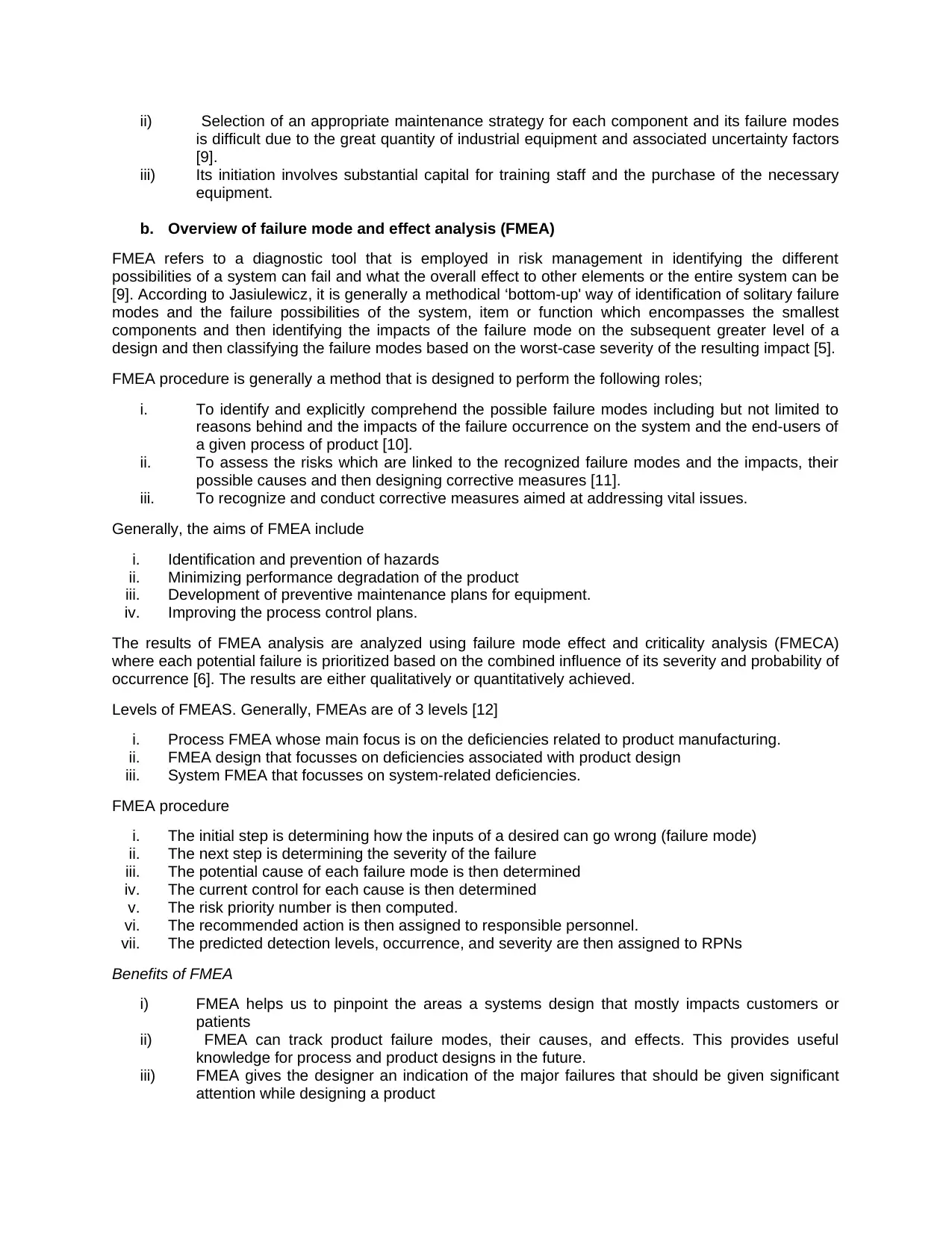
ii) Selection of an appropriate maintenance strategy for each component and its failure modes
is difficult due to the great quantity of industrial equipment and associated uncertainty factors
[9].
iii) Its initiation involves substantial capital for training staff and the purchase of the necessary
equipment.
b. Overview of failure mode and effect analysis (FMEA)
FMEA refers to a diagnostic tool that is employed in risk management in identifying the different
possibilities of a system can fail and what the overall effect to other elements or the entire system can be
[9]. According to Jasiulewicz, it is generally a methodical ‘bottom-up' way of identification of solitary failure
modes and the failure possibilities of the system, item or function which encompasses the smallest
components and then identifying the impacts of the failure mode on the subsequent greater level of a
design and then classifying the failure modes based on the worst-case severity of the resulting impact [5].
FMEA procedure is generally a method that is designed to perform the following roles;
i. To identify and explicitly comprehend the possible failure modes including but not limited to
reasons behind and the impacts of the failure occurrence on the system and the end-users of
a given process of product [10].
ii. To assess the risks which are linked to the recognized failure modes and the impacts, their
possible causes and then designing corrective measures [11].
iii. To recognize and conduct corrective measures aimed at addressing vital issues.
Generally, the aims of FMEA include
i. Identification and prevention of hazards
ii. Minimizing performance degradation of the product
iii. Development of preventive maintenance plans for equipment.
iv. Improving the process control plans.
The results of FMEA analysis are analyzed using failure mode effect and criticality analysis (FMECA)
where each potential failure is prioritized based on the combined influence of its severity and probability of
occurrence [6]. The results are either qualitatively or quantitatively achieved.
Levels of FMEAS. Generally, FMEAs are of 3 levels [12]
i. Process FMEA whose main focus is on the deficiencies related to product manufacturing.
ii. FMEA design that focusses on deficiencies associated with product design
iii. System FMEA that focusses on system-related deficiencies.
FMEA procedure
i. The initial step is determining how the inputs of a desired can go wrong (failure mode)
ii. The next step is determining the severity of the failure
iii. The potential cause of each failure mode is then determined
iv. The current control for each cause is then determined
v. The risk priority number is then computed.
vi. The recommended action is then assigned to responsible personnel.
vii. The predicted detection levels, occurrence, and severity are then assigned to RPNs
Benefits of FMEA
i) FMEA helps us to pinpoint the areas a systems design that mostly impacts customers or
patients
ii) FMEA can track product failure modes, their causes, and effects. This provides useful
knowledge for process and product designs in the future.
iii) FMEA gives the designer an indication of the major failures that should be given significant
attention while designing a product
is difficult due to the great quantity of industrial equipment and associated uncertainty factors
[9].
iii) Its initiation involves substantial capital for training staff and the purchase of the necessary
equipment.
b. Overview of failure mode and effect analysis (FMEA)
FMEA refers to a diagnostic tool that is employed in risk management in identifying the different
possibilities of a system can fail and what the overall effect to other elements or the entire system can be
[9]. According to Jasiulewicz, it is generally a methodical ‘bottom-up' way of identification of solitary failure
modes and the failure possibilities of the system, item or function which encompasses the smallest
components and then identifying the impacts of the failure mode on the subsequent greater level of a
design and then classifying the failure modes based on the worst-case severity of the resulting impact [5].
FMEA procedure is generally a method that is designed to perform the following roles;
i. To identify and explicitly comprehend the possible failure modes including but not limited to
reasons behind and the impacts of the failure occurrence on the system and the end-users of
a given process of product [10].
ii. To assess the risks which are linked to the recognized failure modes and the impacts, their
possible causes and then designing corrective measures [11].
iii. To recognize and conduct corrective measures aimed at addressing vital issues.
Generally, the aims of FMEA include
i. Identification and prevention of hazards
ii. Minimizing performance degradation of the product
iii. Development of preventive maintenance plans for equipment.
iv. Improving the process control plans.
The results of FMEA analysis are analyzed using failure mode effect and criticality analysis (FMECA)
where each potential failure is prioritized based on the combined influence of its severity and probability of
occurrence [6]. The results are either qualitatively or quantitatively achieved.
Levels of FMEAS. Generally, FMEAs are of 3 levels [12]
i. Process FMEA whose main focus is on the deficiencies related to product manufacturing.
ii. FMEA design that focusses on deficiencies associated with product design
iii. System FMEA that focusses on system-related deficiencies.
FMEA procedure
i. The initial step is determining how the inputs of a desired can go wrong (failure mode)
ii. The next step is determining the severity of the failure
iii. The potential cause of each failure mode is then determined
iv. The current control for each cause is then determined
v. The risk priority number is then computed.
vi. The recommended action is then assigned to responsible personnel.
vii. The predicted detection levels, occurrence, and severity are then assigned to RPNs
Benefits of FMEA
i) FMEA helps us to pinpoint the areas a systems design that mostly impacts customers or
patients
ii) FMEA can track product failure modes, their causes, and effects. This provides useful
knowledge for process and product designs in the future.
iii) FMEA gives the designer an indication of the major failures that should be given significant
attention while designing a product
⊘ This is a preview!⊘
Do you want full access?
Subscribe today to unlock all pages.

Trusted by 1+ million students worldwide
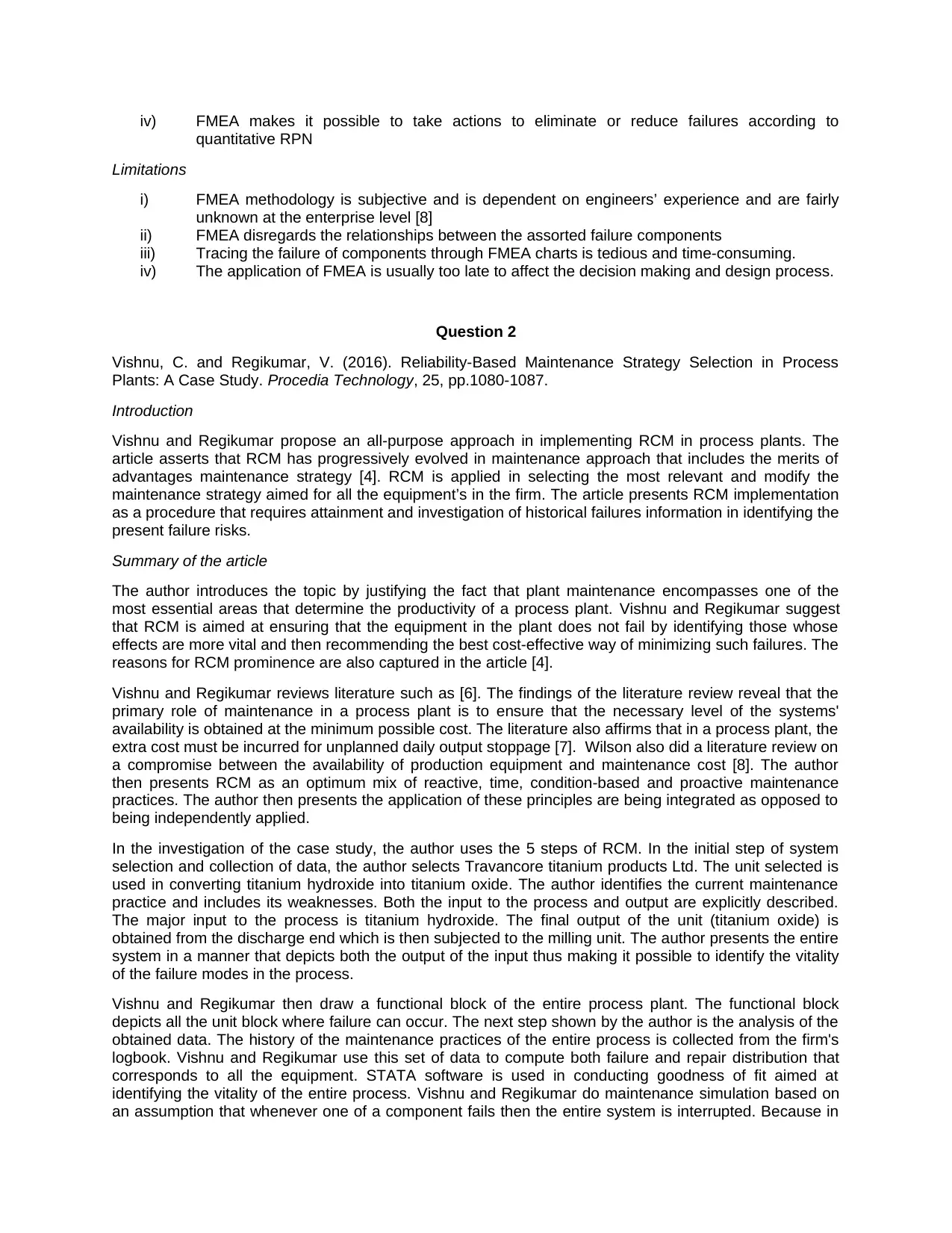
iv) FMEA makes it possible to take actions to eliminate or reduce failures according to
quantitative RPN
Limitations
i) FMEA methodology is subjective and is dependent on engineers’ experience and are fairly
unknown at the enterprise level [8]
ii) FMEA disregards the relationships between the assorted failure components
iii) Tracing the failure of components through FMEA charts is tedious and time-consuming.
iv) The application of FMEA is usually too late to affect the decision making and design process.
Question 2
Vishnu, C. and Regikumar, V. (2016). Reliability-Based Maintenance Strategy Selection in Process
Plants: A Case Study. Procedia Technology, 25, pp.1080-1087.
Introduction
Vishnu and Regikumar propose an all-purpose approach in implementing RCM in process plants. The
article asserts that RCM has progressively evolved in maintenance approach that includes the merits of
advantages maintenance strategy [4]. RCM is applied in selecting the most relevant and modify the
maintenance strategy aimed for all the equipment’s in the firm. The article presents RCM implementation
as a procedure that requires attainment and investigation of historical failures information in identifying the
present failure risks.
Summary of the article
The author introduces the topic by justifying the fact that plant maintenance encompasses one of the
most essential areas that determine the productivity of a process plant. Vishnu and Regikumar suggest
that RCM is aimed at ensuring that the equipment in the plant does not fail by identifying those whose
effects are more vital and then recommending the best cost-effective way of minimizing such failures. The
reasons for RCM prominence are also captured in the article [4].
Vishnu and Regikumar reviews literature such as [6]. The findings of the literature review reveal that the
primary role of maintenance in a process plant is to ensure that the necessary level of the systems'
availability is obtained at the minimum possible cost. The literature also affirms that in a process plant, the
extra cost must be incurred for unplanned daily output stoppage [7]. Wilson also did a literature review on
a compromise between the availability of production equipment and maintenance cost [8]. The author
then presents RCM as an optimum mix of reactive, time, condition-based and proactive maintenance
practices. The author then presents the application of these principles are being integrated as opposed to
being independently applied.
In the investigation of the case study, the author uses the 5 steps of RCM. In the initial step of system
selection and collection of data, the author selects Travancore titanium products Ltd. The unit selected is
used in converting titanium hydroxide into titanium oxide. The author identifies the current maintenance
practice and includes its weaknesses. Both the input to the process and output are explicitly described.
The major input to the process is titanium hydroxide. The final output of the unit (titanium oxide) is
obtained from the discharge end which is then subjected to the milling unit. The author presents the entire
system in a manner that depicts both the output of the input thus making it possible to identify the vitality
of the failure modes in the process.
Vishnu and Regikumar then draw a functional block of the entire process plant. The functional block
depicts all the unit block where failure can occur. The next step shown by the author is the analysis of the
obtained data. The history of the maintenance practices of the entire process is collected from the firm's
logbook. Vishnu and Regikumar use this set of data to compute both failure and repair distribution that
corresponds to all the equipment. STATA software is used in conducting goodness of fit aimed at
identifying the vitality of the entire process. Vishnu and Regikumar do maintenance simulation based on
an assumption that whenever one of a component fails then the entire system is interrupted. Because in
quantitative RPN
Limitations
i) FMEA methodology is subjective and is dependent on engineers’ experience and are fairly
unknown at the enterprise level [8]
ii) FMEA disregards the relationships between the assorted failure components
iii) Tracing the failure of components through FMEA charts is tedious and time-consuming.
iv) The application of FMEA is usually too late to affect the decision making and design process.
Question 2
Vishnu, C. and Regikumar, V. (2016). Reliability-Based Maintenance Strategy Selection in Process
Plants: A Case Study. Procedia Technology, 25, pp.1080-1087.
Introduction
Vishnu and Regikumar propose an all-purpose approach in implementing RCM in process plants. The
article asserts that RCM has progressively evolved in maintenance approach that includes the merits of
advantages maintenance strategy [4]. RCM is applied in selecting the most relevant and modify the
maintenance strategy aimed for all the equipment’s in the firm. The article presents RCM implementation
as a procedure that requires attainment and investigation of historical failures information in identifying the
present failure risks.
Summary of the article
The author introduces the topic by justifying the fact that plant maintenance encompasses one of the
most essential areas that determine the productivity of a process plant. Vishnu and Regikumar suggest
that RCM is aimed at ensuring that the equipment in the plant does not fail by identifying those whose
effects are more vital and then recommending the best cost-effective way of minimizing such failures. The
reasons for RCM prominence are also captured in the article [4].
Vishnu and Regikumar reviews literature such as [6]. The findings of the literature review reveal that the
primary role of maintenance in a process plant is to ensure that the necessary level of the systems'
availability is obtained at the minimum possible cost. The literature also affirms that in a process plant, the
extra cost must be incurred for unplanned daily output stoppage [7]. Wilson also did a literature review on
a compromise between the availability of production equipment and maintenance cost [8]. The author
then presents RCM as an optimum mix of reactive, time, condition-based and proactive maintenance
practices. The author then presents the application of these principles are being integrated as opposed to
being independently applied.
In the investigation of the case study, the author uses the 5 steps of RCM. In the initial step of system
selection and collection of data, the author selects Travancore titanium products Ltd. The unit selected is
used in converting titanium hydroxide into titanium oxide. The author identifies the current maintenance
practice and includes its weaknesses. Both the input to the process and output are explicitly described.
The major input to the process is titanium hydroxide. The final output of the unit (titanium oxide) is
obtained from the discharge end which is then subjected to the milling unit. The author presents the entire
system in a manner that depicts both the output of the input thus making it possible to identify the vitality
of the failure modes in the process.
Vishnu and Regikumar then draw a functional block of the entire process plant. The functional block
depicts all the unit block where failure can occur. The next step shown by the author is the analysis of the
obtained data. The history of the maintenance practices of the entire process is collected from the firm's
logbook. Vishnu and Regikumar use this set of data to compute both failure and repair distribution that
corresponds to all the equipment. STATA software is used in conducting goodness of fit aimed at
identifying the vitality of the entire process. Vishnu and Regikumar do maintenance simulation based on
an assumption that whenever one of a component fails then the entire system is interrupted. Because in
Paraphrase This Document
Need a fresh take? Get an instant paraphrase of this document with our AI Paraphraser
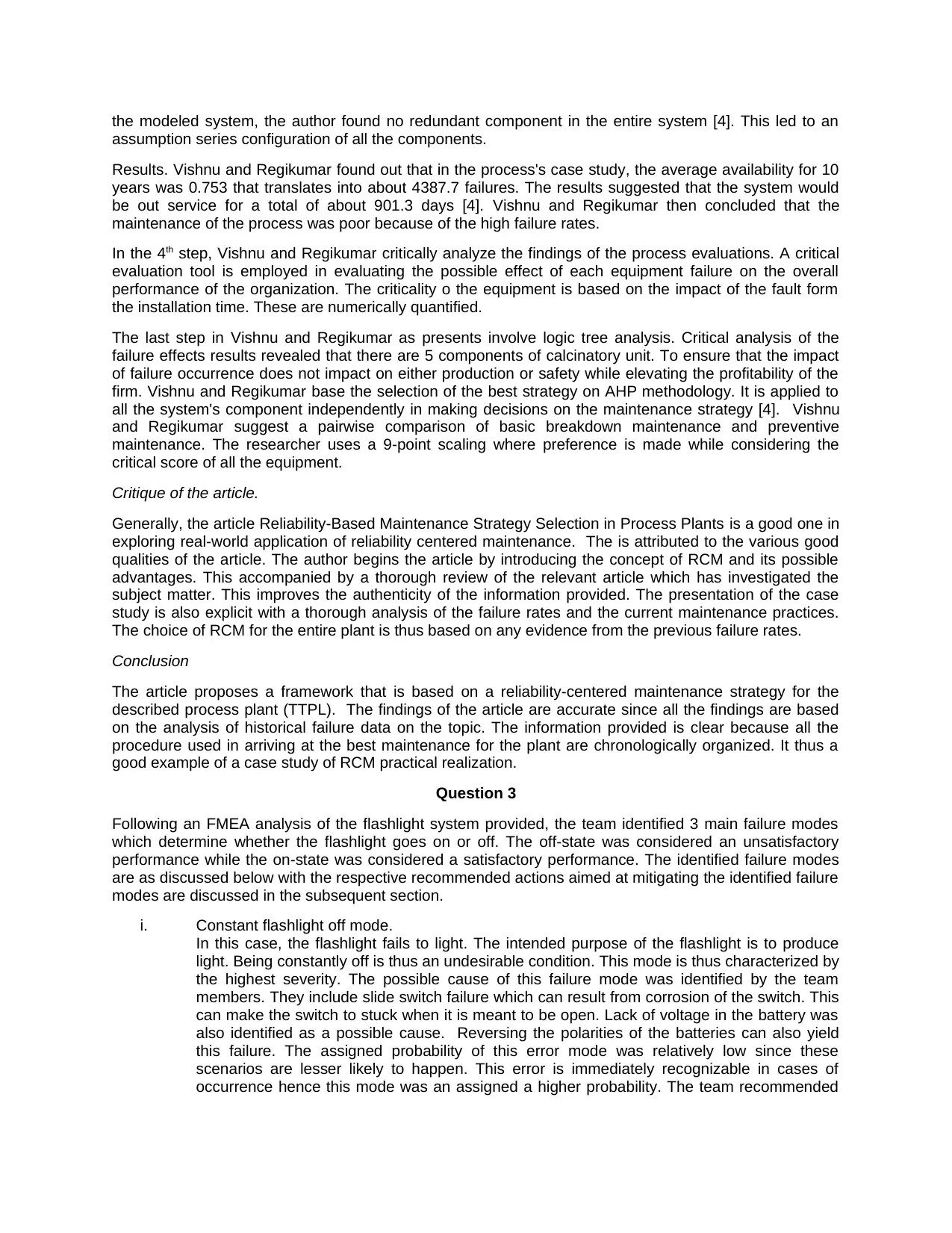
the modeled system, the author found no redundant component in the entire system [4]. This led to an
assumption series configuration of all the components.
Results. Vishnu and Regikumar found out that in the process's case study, the average availability for 10
years was 0.753 that translates into about 4387.7 failures. The results suggested that the system would
be out service for a total of about 901.3 days [4]. Vishnu and Regikumar then concluded that the
maintenance of the process was poor because of the high failure rates.
In the 4th step, Vishnu and Regikumar critically analyze the findings of the process evaluations. A critical
evaluation tool is employed in evaluating the possible effect of each equipment failure on the overall
performance of the organization. The criticality o the equipment is based on the impact of the fault form
the installation time. These are numerically quantified.
The last step in Vishnu and Regikumar as presents involve logic tree analysis. Critical analysis of the
failure effects results revealed that there are 5 components of calcinatory unit. To ensure that the impact
of failure occurrence does not impact on either production or safety while elevating the profitability of the
firm. Vishnu and Regikumar base the selection of the best strategy on AHP methodology. It is applied to
all the system's component independently in making decisions on the maintenance strategy [4]. Vishnu
and Regikumar suggest a pairwise comparison of basic breakdown maintenance and preventive
maintenance. The researcher uses a 9-point scaling where preference is made while considering the
critical score of all the equipment.
Critique of the article.
Generally, the article Reliability-Based Maintenance Strategy Selection in Process Plants is a good one in
exploring real-world application of reliability centered maintenance. The is attributed to the various good
qualities of the article. The author begins the article by introducing the concept of RCM and its possible
advantages. This accompanied by a thorough review of the relevant article which has investigated the
subject matter. This improves the authenticity of the information provided. The presentation of the case
study is also explicit with a thorough analysis of the failure rates and the current maintenance practices.
The choice of RCM for the entire plant is thus based on any evidence from the previous failure rates.
Conclusion
The article proposes a framework that is based on a reliability-centered maintenance strategy for the
described process plant (TTPL). The findings of the article are accurate since all the findings are based
on the analysis of historical failure data on the topic. The information provided is clear because all the
procedure used in arriving at the best maintenance for the plant are chronologically organized. It thus a
good example of a case study of RCM practical realization.
Question 3
Following an FMEA analysis of the flashlight system provided, the team identified 3 main failure modes
which determine whether the flashlight goes on or off. The off-state was considered an unsatisfactory
performance while the on-state was considered a satisfactory performance. The identified failure modes
are as discussed below with the respective recommended actions aimed at mitigating the identified failure
modes are discussed in the subsequent section.
i. Constant flashlight off mode.
In this case, the flashlight fails to light. The intended purpose of the flashlight is to produce
light. Being constantly off is thus an undesirable condition. This mode is thus characterized by
the highest severity. The possible cause of this failure mode was identified by the team
members. They include slide switch failure which can result from corrosion of the switch. This
can make the switch to stuck when it is meant to be open. Lack of voltage in the battery was
also identified as a possible cause. Reversing the polarities of the batteries can also yield
this failure. The assigned probability of this error mode was relatively low since these
scenarios are lesser likely to happen. This error is immediately recognizable in cases of
occurrence hence this mode was an assigned a higher probability. The team recommended
assumption series configuration of all the components.
Results. Vishnu and Regikumar found out that in the process's case study, the average availability for 10
years was 0.753 that translates into about 4387.7 failures. The results suggested that the system would
be out service for a total of about 901.3 days [4]. Vishnu and Regikumar then concluded that the
maintenance of the process was poor because of the high failure rates.
In the 4th step, Vishnu and Regikumar critically analyze the findings of the process evaluations. A critical
evaluation tool is employed in evaluating the possible effect of each equipment failure on the overall
performance of the organization. The criticality o the equipment is based on the impact of the fault form
the installation time. These are numerically quantified.
The last step in Vishnu and Regikumar as presents involve logic tree analysis. Critical analysis of the
failure effects results revealed that there are 5 components of calcinatory unit. To ensure that the impact
of failure occurrence does not impact on either production or safety while elevating the profitability of the
firm. Vishnu and Regikumar base the selection of the best strategy on AHP methodology. It is applied to
all the system's component independently in making decisions on the maintenance strategy [4]. Vishnu
and Regikumar suggest a pairwise comparison of basic breakdown maintenance and preventive
maintenance. The researcher uses a 9-point scaling where preference is made while considering the
critical score of all the equipment.
Critique of the article.
Generally, the article Reliability-Based Maintenance Strategy Selection in Process Plants is a good one in
exploring real-world application of reliability centered maintenance. The is attributed to the various good
qualities of the article. The author begins the article by introducing the concept of RCM and its possible
advantages. This accompanied by a thorough review of the relevant article which has investigated the
subject matter. This improves the authenticity of the information provided. The presentation of the case
study is also explicit with a thorough analysis of the failure rates and the current maintenance practices.
The choice of RCM for the entire plant is thus based on any evidence from the previous failure rates.
Conclusion
The article proposes a framework that is based on a reliability-centered maintenance strategy for the
described process plant (TTPL). The findings of the article are accurate since all the findings are based
on the analysis of historical failure data on the topic. The information provided is clear because all the
procedure used in arriving at the best maintenance for the plant are chronologically organized. It thus a
good example of a case study of RCM practical realization.
Question 3
Following an FMEA analysis of the flashlight system provided, the team identified 3 main failure modes
which determine whether the flashlight goes on or off. The off-state was considered an unsatisfactory
performance while the on-state was considered a satisfactory performance. The identified failure modes
are as discussed below with the respective recommended actions aimed at mitigating the identified failure
modes are discussed in the subsequent section.
i. Constant flashlight off mode.
In this case, the flashlight fails to light. The intended purpose of the flashlight is to produce
light. Being constantly off is thus an undesirable condition. This mode is thus characterized by
the highest severity. The possible cause of this failure mode was identified by the team
members. They include slide switch failure which can result from corrosion of the switch. This
can make the switch to stuck when it is meant to be open. Lack of voltage in the battery was
also identified as a possible cause. Reversing the polarities of the batteries can also yield
this failure. The assigned probability of this error mode was relatively low since these
scenarios are lesser likely to happen. This error is immediately recognizable in cases of
occurrence hence this mode was an assigned a higher probability. The team recommended
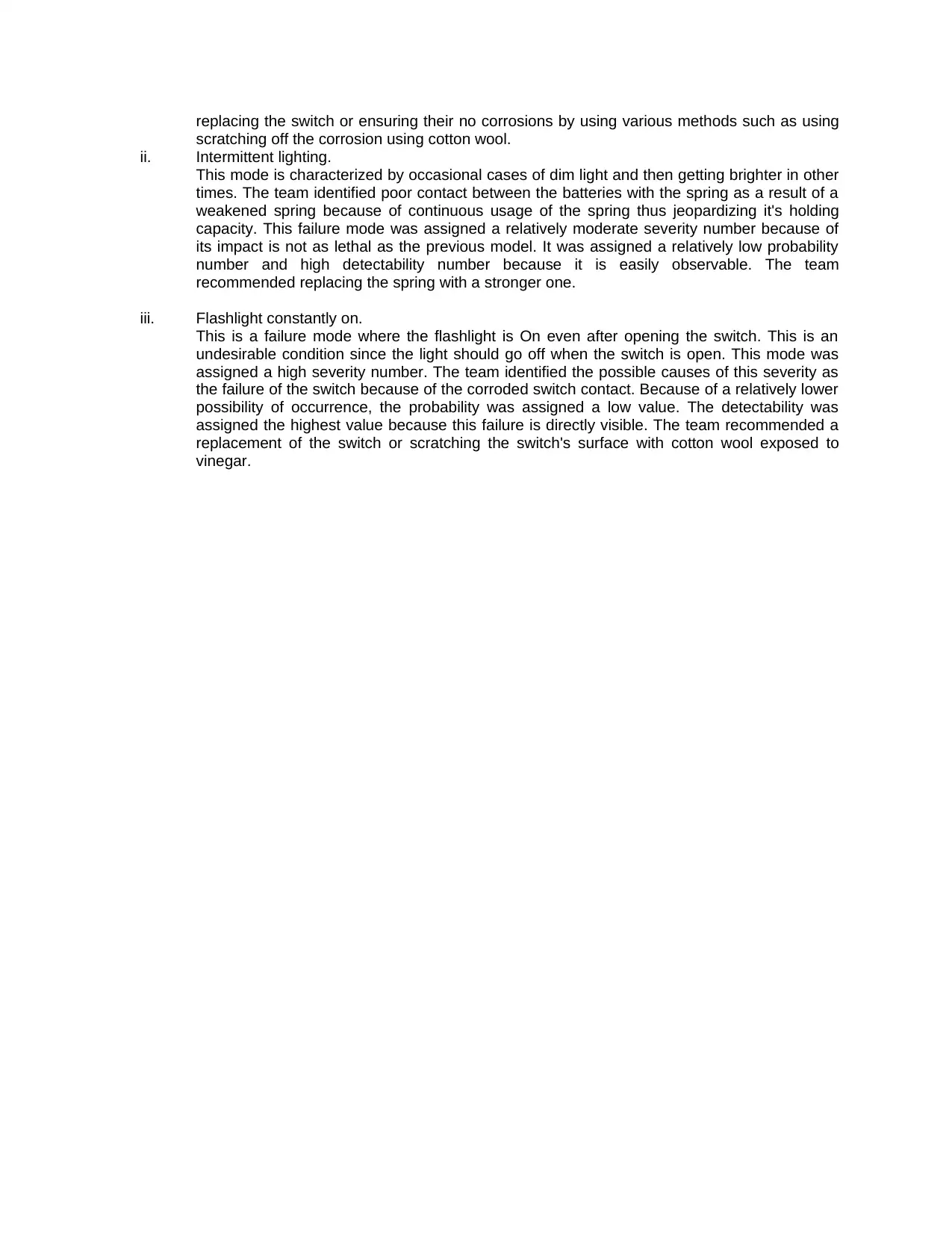
replacing the switch or ensuring their no corrosions by using various methods such as using
scratching off the corrosion using cotton wool.
ii. Intermittent lighting.
This mode is characterized by occasional cases of dim light and then getting brighter in other
times. The team identified poor contact between the batteries with the spring as a result of a
weakened spring because of continuous usage of the spring thus jeopardizing it's holding
capacity. This failure mode was assigned a relatively moderate severity number because of
its impact is not as lethal as the previous model. It was assigned a relatively low probability
number and high detectability number because it is easily observable. The team
recommended replacing the spring with a stronger one.
iii. Flashlight constantly on.
This is a failure mode where the flashlight is On even after opening the switch. This is an
undesirable condition since the light should go off when the switch is open. This mode was
assigned a high severity number. The team identified the possible causes of this severity as
the failure of the switch because of the corroded switch contact. Because of a relatively lower
possibility of occurrence, the probability was assigned a low value. The detectability was
assigned the highest value because this failure is directly visible. The team recommended a
replacement of the switch or scratching the switch's surface with cotton wool exposed to
vinegar.
scratching off the corrosion using cotton wool.
ii. Intermittent lighting.
This mode is characterized by occasional cases of dim light and then getting brighter in other
times. The team identified poor contact between the batteries with the spring as a result of a
weakened spring because of continuous usage of the spring thus jeopardizing it's holding
capacity. This failure mode was assigned a relatively moderate severity number because of
its impact is not as lethal as the previous model. It was assigned a relatively low probability
number and high detectability number because it is easily observable. The team
recommended replacing the spring with a stronger one.
iii. Flashlight constantly on.
This is a failure mode where the flashlight is On even after opening the switch. This is an
undesirable condition since the light should go off when the switch is open. This mode was
assigned a high severity number. The team identified the possible causes of this severity as
the failure of the switch because of the corroded switch contact. Because of a relatively lower
possibility of occurrence, the probability was assigned a low value. The detectability was
assigned the highest value because this failure is directly visible. The team recommended a
replacement of the switch or scratching the switch's surface with cotton wool exposed to
vinegar.
⊘ This is a preview!⊘
Do you want full access?
Subscribe today to unlock all pages.

Trusted by 1+ million students worldwide
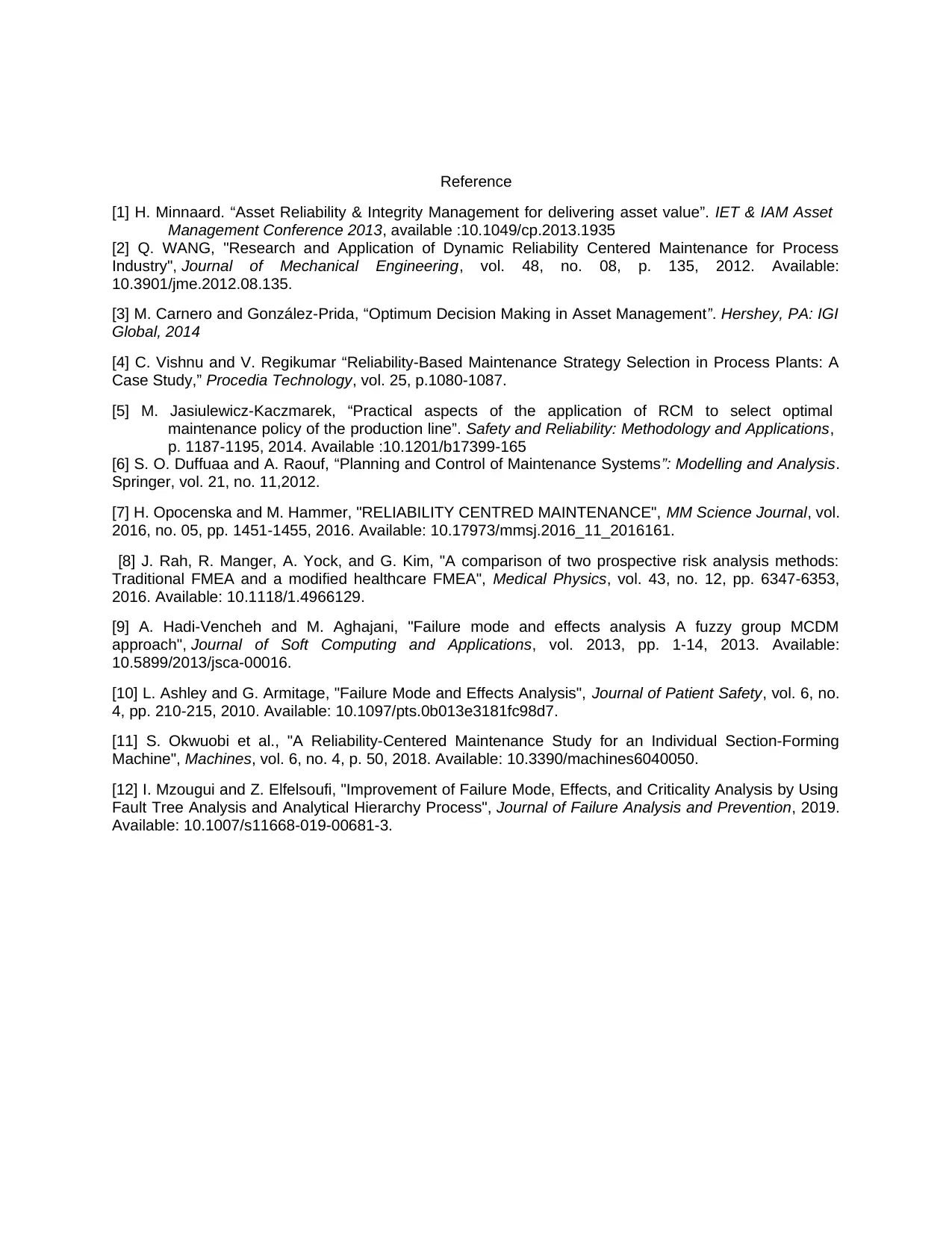
Reference
[1] H. Minnaard. “Asset Reliability & Integrity Management for delivering asset value”. IET & IAM Asset
Management Conference 2013, available :10.1049/cp.2013.1935
[2] Q. WANG, "Research and Application of Dynamic Reliability Centered Maintenance for Process
Industry", Journal of Mechanical Engineering, vol. 48, no. 08, p. 135, 2012. Available:
10.3901/jme.2012.08.135.
[3] M. Carnero and González-Prida, “Optimum Decision Making in Asset Management”. Hershey, PA: IGI
Global, 2014
[4] C. Vishnu and V. Regikumar “Reliability-Based Maintenance Strategy Selection in Process Plants: A
Case Study,” Procedia Technology, vol. 25, p.1080-1087.
[5] M. Jasiulewicz-Kaczmarek, “Practical aspects of the application of RCM to select optimal
maintenance policy of the production line”. Safety and Reliability: Methodology and Applications,
p. 1187-1195, 2014. Available :10.1201/b17399-165
[6] S. O. Duffuaa and A. Raouf, “Planning and Control of Maintenance Systems”: Modelling and Analysis.
Springer, vol. 21, no. 11,2012.
[7] H. Opocenska and M. Hammer, "RELIABILITY CENTRED MAINTENANCE", MM Science Journal, vol.
2016, no. 05, pp. 1451-1455, 2016. Available: 10.17973/mmsj.2016_11_2016161.
[8] J. Rah, R. Manger, A. Yock, and G. Kim, "A comparison of two prospective risk analysis methods:
Traditional FMEA and a modified healthcare FMEA", Medical Physics, vol. 43, no. 12, pp. 6347-6353,
2016. Available: 10.1118/1.4966129.
[9] A. Hadi-Vencheh and M. Aghajani, "Failure mode and effects analysis A fuzzy group MCDM
approach", Journal of Soft Computing and Applications, vol. 2013, pp. 1-14, 2013. Available:
10.5899/2013/jsca-00016.
[10] L. Ashley and G. Armitage, "Failure Mode and Effects Analysis", Journal of Patient Safety, vol. 6, no.
4, pp. 210-215, 2010. Available: 10.1097/pts.0b013e3181fc98d7.
[11] S. Okwuobi et al., "A Reliability-Centered Maintenance Study for an Individual Section-Forming
Machine", Machines, vol. 6, no. 4, p. 50, 2018. Available: 10.3390/machines6040050.
[12] I. Mzougui and Z. Elfelsoufi, "Improvement of Failure Mode, Effects, and Criticality Analysis by Using
Fault Tree Analysis and Analytical Hierarchy Process", Journal of Failure Analysis and Prevention, 2019.
Available: 10.1007/s11668-019-00681-3.
[1] H. Minnaard. “Asset Reliability & Integrity Management for delivering asset value”. IET & IAM Asset
Management Conference 2013, available :10.1049/cp.2013.1935
[2] Q. WANG, "Research and Application of Dynamic Reliability Centered Maintenance for Process
Industry", Journal of Mechanical Engineering, vol. 48, no. 08, p. 135, 2012. Available:
10.3901/jme.2012.08.135.
[3] M. Carnero and González-Prida, “Optimum Decision Making in Asset Management”. Hershey, PA: IGI
Global, 2014
[4] C. Vishnu and V. Regikumar “Reliability-Based Maintenance Strategy Selection in Process Plants: A
Case Study,” Procedia Technology, vol. 25, p.1080-1087.
[5] M. Jasiulewicz-Kaczmarek, “Practical aspects of the application of RCM to select optimal
maintenance policy of the production line”. Safety and Reliability: Methodology and Applications,
p. 1187-1195, 2014. Available :10.1201/b17399-165
[6] S. O. Duffuaa and A. Raouf, “Planning and Control of Maintenance Systems”: Modelling and Analysis.
Springer, vol. 21, no. 11,2012.
[7] H. Opocenska and M. Hammer, "RELIABILITY CENTRED MAINTENANCE", MM Science Journal, vol.
2016, no. 05, pp. 1451-1455, 2016. Available: 10.17973/mmsj.2016_11_2016161.
[8] J. Rah, R. Manger, A. Yock, and G. Kim, "A comparison of two prospective risk analysis methods:
Traditional FMEA and a modified healthcare FMEA", Medical Physics, vol. 43, no. 12, pp. 6347-6353,
2016. Available: 10.1118/1.4966129.
[9] A. Hadi-Vencheh and M. Aghajani, "Failure mode and effects analysis A fuzzy group MCDM
approach", Journal of Soft Computing and Applications, vol. 2013, pp. 1-14, 2013. Available:
10.5899/2013/jsca-00016.
[10] L. Ashley and G. Armitage, "Failure Mode and Effects Analysis", Journal of Patient Safety, vol. 6, no.
4, pp. 210-215, 2010. Available: 10.1097/pts.0b013e3181fc98d7.
[11] S. Okwuobi et al., "A Reliability-Centered Maintenance Study for an Individual Section-Forming
Machine", Machines, vol. 6, no. 4, p. 50, 2018. Available: 10.3390/machines6040050.
[12] I. Mzougui and Z. Elfelsoufi, "Improvement of Failure Mode, Effects, and Criticality Analysis by Using
Fault Tree Analysis and Analytical Hierarchy Process", Journal of Failure Analysis and Prevention, 2019.
Available: 10.1007/s11668-019-00681-3.
1 out of 7
Related Documents
Your All-in-One AI-Powered Toolkit for Academic Success.
+13062052269
info@desklib.com
Available 24*7 on WhatsApp / Email
![[object Object]](/_next/static/media/star-bottom.7253800d.svg)
Unlock your academic potential
Copyright © 2020–2025 A2Z Services. All Rights Reserved. Developed and managed by ZUCOL.





